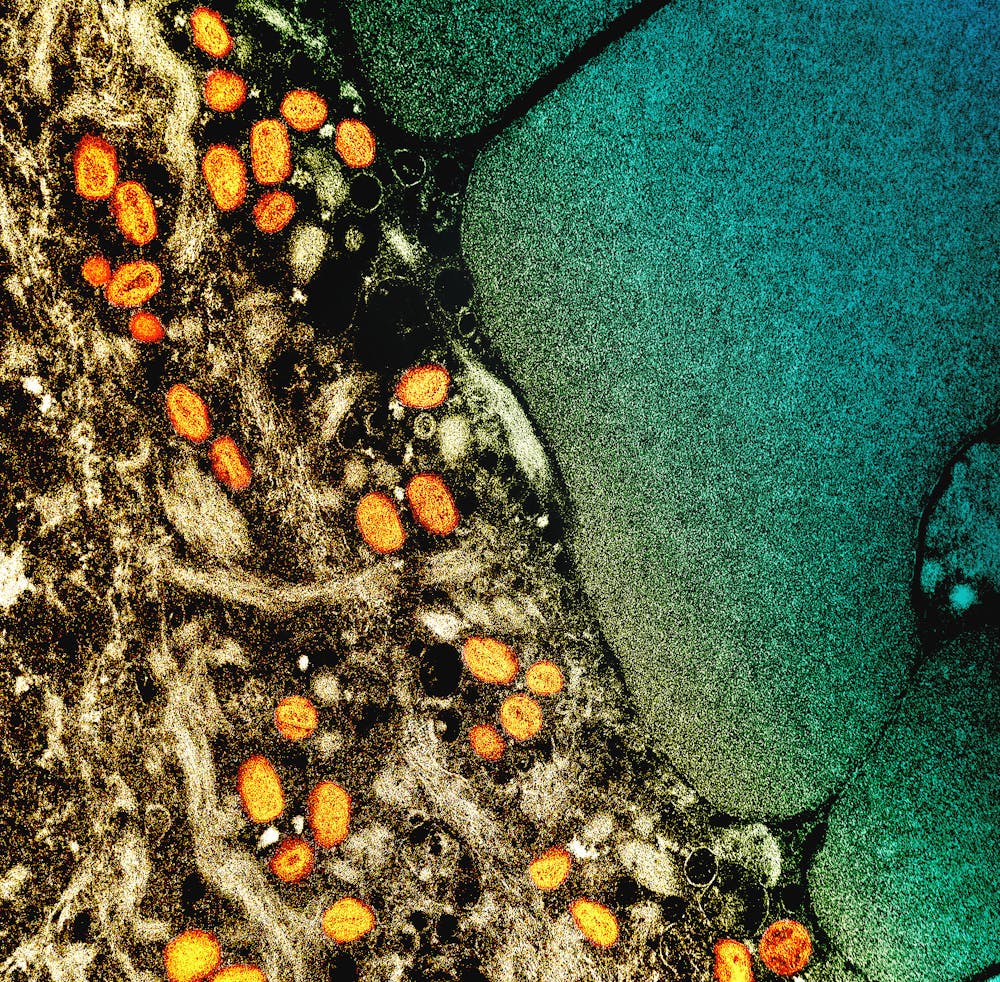As we are approaching finals season, let’s take some time to acknowledge the hard work of scientists around the world and learn from their commitment to their work. This week’s science news covers new insights into the monkeypox virus in Congo, robots made of human cells, archaeological preservation in Ukraine and an AI-robot that can predict and synthesize new materials.
New monkeypox infections in Congo are linked to sexual contact
The first case of monkeypox (mpox) infection in humans was documented in Congo in 1970. Mpox continues to affect people in Congo today; the nation’s mpox outbreak just this year has led to more cases and deaths than mpox outbreaks across the whole world for the past two years. The cluster of mpox infections linked to sexual contact adds more challenges and urgency to address the mpox outbreak in Congo.
Mpox infection usually causes rashes on skin surfaces as well as fever, swollen lymph nodes and respiratory difficulties. The strain that spread in the global mpox epidemic in 2022 was clade IIb, whose mutations can explain its mode of transmission through sex. However, there is no evidence that the viral strain in Congo, clade I, has experienced the same mutations. The investigation of whether any genetic changes have occurred is still ongoing.
It is concerning that Congo still does not have access to the mpox vaccine that had been available to many other countries during the mpox epidemic in 2022. The CEO of Bavarian Nordic, the company whose vaccine was approved by the Food and Drug Administration, claimed that Congo has not requested the vaccines yet. The reluctance to introduce the vaccine in Congo can be due to the sporadic distribution of infections in the country. However, experts suggest targeting groups at risk of sexual transmission as an efficient way to introduce the vaccine to combat the mpox outbreak in Congo.
Human cells can form “anthrobots” to heal and cure the human body
A team of researchers at Tufts University engineered an organoid consisting of human tracheal cells that exhibited healing function in damaged nerve tissue. The “anthrobot,” meaning a robot made from human cells, has the potential for healing, screening for new drugs and carcinogens and drug delivery.
The researchers cultured individual tracheal cells in an extracellular matrix and formed spherical organoids. The cilia that would help the anthrobots move initially grew inside of the cells. In order for the cilia to contribute to locomotion, the researchers treated the cells with a special solution that turned the cilia out to aid with mobility. Interestingly, each organoid showed diverse properties, including size, shape and cilia distribution.
When introduced to damaged nerve tissue, the anthrobots moved through the wound and formed bridges between the severed tissue. The researchers thought that the living nature of anthrobots, which drugs lack, signals the living cells on both sides of the tissue of each other’s presence and facilitates repair and new tissue growth.
Findings about anthrobots can have important implications in medicine. For example, anthrobots can be used in screening for new drugs. The mobile nature of anthrobots powered by cilia is an easy-to-identify marker to monitor the effect of the drug on the status of living cells. The research team also wants to investigate anthrobots’ potential sensing memory abilities, which can be useful for monitoring health status.
The Ukraine’s War has undermined archaeological sites, and preservation is urgent
Since Russia’s invasion of Ukraine in February 2022, Ukraine has experienced extensive archaeological destruction as a result of devastating war impacts such as bombing and trenches. Among the damaged buildings are churches and museums that contain important cultural legacies, as well as underground archaeological sites that are undocumented.
Ukraine has archaeological knowledge whose value is still waiting to be discovered. For example, it was once the home to Yamnaya, who were the earliest horse riders and migrated to central Europe. The ancestry of most present-day Europeans can be traced back to the Yamnaya. Fortunately, a team of archaeologists from Ukraine and the U.S. is working to evaluate the scope and extent of war damage and devise solutions to preserve these heritage sites.
The researchers emphasized the difficulty of evaluating the extent of damage from outside of the country. Civilian drones are prohibited. Satellite images during wartime are low-resolution, and Ukraine’s forest-rich topography presents more challenges for clear visualization.
Given the limits of remote research, the archaeologists decided to begin their in-person work in liberated areas first. They planned to first pinpoint the archaeological sites, evaluate the damage and come up with solutions to mitigate further damage and implement preservation efforts. As winter approaches, the researchers emphasize the urgency of preservation efforts because much archaeological evidence could be exposed to severe weather.
AI and robots can collaborate to computationally identify and synthesize new material compounds
The A-Lab is a system that combines artificial intelligence (AI) and robots. It learns from past research in the literature, such as the Materials Project, and predicts new inorganic compounds that would be stable.
Compared to how scientists predict and synthesize materials in the lab by manipulating compounds by hand and other technologies, the A-lab can greatly accelerate the process of discovering new materials that can be more efficient in supporting existing tools and more sustainable for the environment.
The A-lab is also capable of synthesizing the materials it predicts. Without human intervention, A-lab produced 41 new inorganic compounds out of 58 target compounds in 17 days. It chose necessary reactants in a lab setting, synthesized the products and analyzed the products. Its active learning algorithm allows the system to learn from its mistakes and come up with methods to perform better.
The researchers will release the list of 381,000 stable compounds predicted and make the code that powers the A-lab available to the public, hoping to see A-lab’s impact in the real world.





